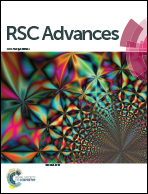Efficient fixation and conversion of CO2 into dimethyl carbonate catalyzed by an imidazolium containing tri-cationic ionic liquid/super base system†
Abstract
The synthesis route used to prepare dimethyl carbonate from CO2 and methanol is a most attractive route from a green chemistry point of view. Herein, we systematically studied binary catalyst systems for the synthesis of dimethyl carbonate from CO2 and methanol. It was found that [GLY(mim)3][NTf2]3IL/DBU, [GLY(mim)3][NTf2]3/MTBD and [GLY(mim)3][NTf2]3/TBD are effective binary catalysts for the direct synthesis of DMC without the need of a dehydration system. In particular, the [GLY(mim)3][NTf2]3 IL/1,8-diazabicyclo[5.4.0]undec-7-ene (DBU) system was found to have 37% MeOH conversion and 93% DMC selectivity under mild reaction conditions. However, the tri-imidazolium salts were compatible with DBU for effective CO2 adsorption, possibly because of the reactive C(2)–H in the imidazolium ring. Furthermore, the [GLY(mim)3][NTf2]3 IL/DBU catalytic system could be easily recovered and reused three times without any obvious loss of catalytic activity. The catalytic reactivity of [GLY(mim)3][NTf2]3 IL/DBU for the synthesis of DMC was proved by its predictable mechanism on the basis of 13C NMR spectroscopy.


 Please wait while we load your content...
Please wait while we load your content...